So this video shows the normal 20 amp plugs share a ground. Assuming they also share a ground with the TT-30 plug, then having two RVs/trailers (with bonded ground/neutrals due to their generators) pluged in, would create a short.
If you have ever been camping with RVs, it's really common to have someone run a small generator and have several RVs plugged into it to run some lights and charge batteries for a few hours every night.
If you have ever been camping with RVs, it's really common to have someone run a small generator and have several RVs plugged into it to run some lights and charge batteries for a few hours every night.





